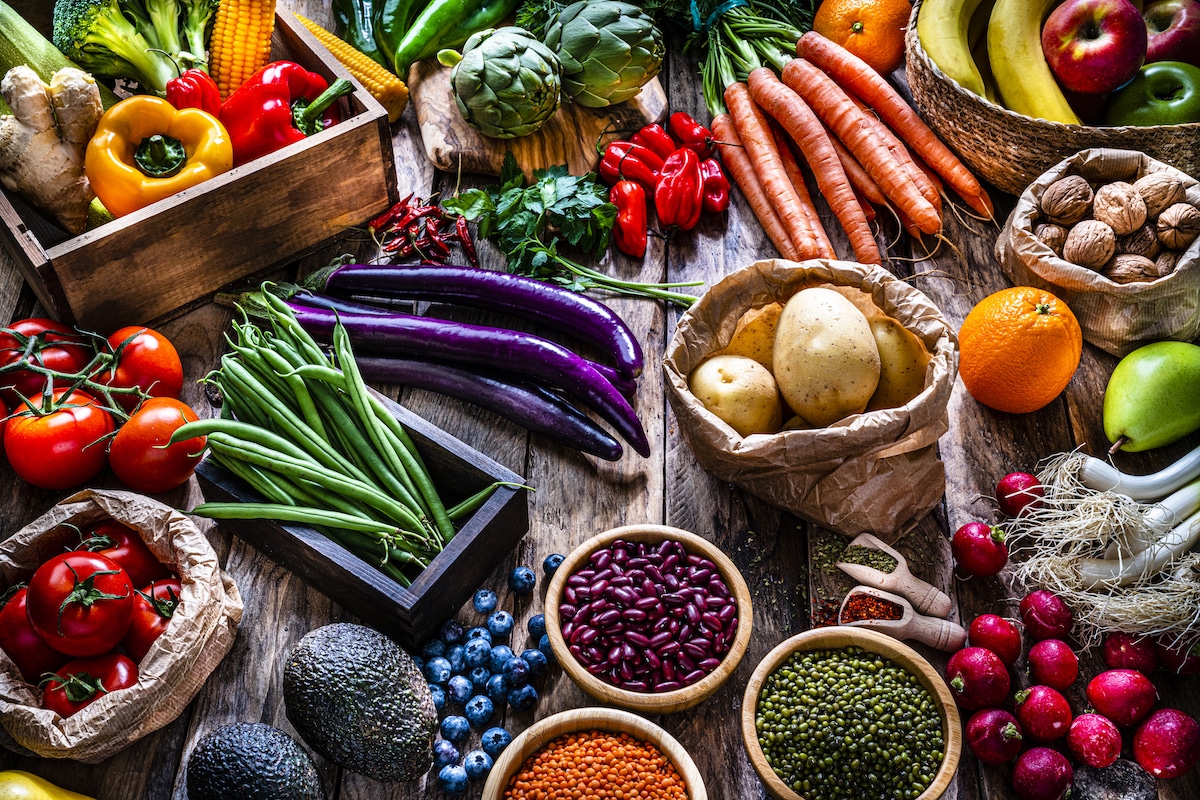Blueberries and Green Beans Added to 2023 ‘Dirty Dozen’

 Why you can trust us
Why you can trust us
Founded in 2005 as an Ohio-based environmental newspaper, EcoWatch is a digital platform dedicated to publishing quality, science-based content on environmental issues, causes, and solutions.
U.S. grocery shoppers take note, it’s that time of year again. The Environmental Working Group (EWG) released on Wednesday its 2023 Shopper’s Guide to Pesticides in Produce, with its annual Dirty Dozen and Clean Fifteen lists of the conventional fruits and vegetables most and least likely to be contaminated with pesticides, and this year’s lists have important new additions.
In particular, blueberries and green beans were both added to the Dirty Dozen, with green beans even testing positive for a neurotoxic insecticide called acephate that the U.S. Environmental Protection Agency (EPA) has already banned.
“They actually took action on acephate for green beans [more than] a decade ago. Yet this most recent round of testing still shows that there’s levels above that EPA limit for acephate on green beans, which sort of highlights this broken regulatory system around pesticide use,” EWG toxicologist Alexis Temkin, Ph.D., told EcoWatch.
New and Repeat Offenders
The EWG Dirty Dozen and Clean Fifteen lists are based on tests of 46,569 samples of 46 fruits and vegetables conducted by the U.S. Department of Agriculture (USDA) and the Food and Drug Administration.
“The really unique thing about the USDA data set is that they basically prepare these fruits and vegetables the way we would use them,” Temkin explained. “So they’re washed or they’re peeled… so the data just really reflects the presence of pesticides on the fruits and vegetables when we get them.”
This year’s round of tests uncovered 251 different pesticides on almost 75 percent of non-organic, fresh produce sold in the U.S. The worst offenders — rated by the percent of samples with two or more pesticides, the average number of pesticides per sample, the average parts per million of pesticides found per sample, the most pesticides found in one sample of the product or the total number of pesticides across all samples — make up the Dirty Dozen.
In 2023, the Dirty Dozen were:
- Strawberries
- Spinach
- Kale, collard and mustard greens
- Peaches
- Pears
- Nectarines
- Apples
- Grapes
- Bell and hot peppers
- Cherries
- Blueberries
- Green beans
As a group, the Dirty Dozen tested positive for 210 different pesticides, and at least one sample of each item tested positive for at least 13 pesticides, with some contaminated with up to 23. Strawberries, spinach and the trio of greens have hovered in the top spots for three years in a row. But blueberries and green beans broke with the past when they edged into the last two spots.
The shuffling on the lists partly reflects the fact that the USDA does not test every fruit and vegetable every year. The last time blueberries were tested, in 2014, 81 percent of samples tested positive for pesticides. During 2020’s and 2021’s testing, more than 90 percent of the samples were dusted in detectible pesticide residues.
The two pesticides of greatest concern found on blueberries were phosmet and malathion. These are both a type of insecticide known as an organophosphate. The recently banned chlorpyrifos is another example. Organophosphates like chlorpyrifos are such a concern because they can be toxic for the brain, harming especially children’s cognitive development. Phosmet, which was found on more than 10 percent of blueberry samples, is currently banned in the European Union. Malathion, which was found on nine percent of samples, is permitted there only in greenhouses.
An organophosphate was also the most alarming pesticide found on green beans, with nearly seven percent of samples testing positive for either acephate or methamidophos, which acephate breaks down into. This despite the fact that the EPA banned acephate for use on green beans in 2011.
“One sample of non-organic green beans had acephate, the banned pesticide, at a level 500 times greater than the limit set by the EPA,” EWG wrote. “And it doesn’t matter whether the beans were grown here or imported — many samples showed acephate far above this EPA limit. Even three organic samples of green beans grown in Mexico detected the chemical.”
In addition to acephate, green beans also tested positive for three pesticides banned in the EU but still permitted in the U.S.:
- Carbendazim, a fungicide classified as a possible carcinogen, was found on a third of the samples tested.
- Bifenthrin, a pyrethroid insecticide classified as a possible carcinogen, was found on around a quarter of the samples tested.
- Chlorothalonil, a fungicide known to damage DNA, was found on more than 15 percent of samples.
In general, pesticide residues were found on almost 90 percent of green bean samples tested in 2020 and 2021, up from less than 75 percent in 2016.
Why This Matters
While the amount of acephate on some green beans may raise alarm, most of the pesticide residues found on fruits and vegetables were below safety thresholds set by the EPA, so why should we be concerned about consuming them?
“The reason we’re concerned about consuming pesticides is that these sorts of exposures to chronic low levels of these mixtures of pesticides have been associated with adverse health effects,” Temkin told EcoWatch.
Those health effects include cancer risk, Type 2 diabetes, reproductive problems and neurotoxicity in children. Indeed, children are especially vulnerable to pesticide exposure.
The National Academies of Sciences first warned about children’s exposure to pesticides three decades ago, and the American Academy of Pediatrics has recommended EWG’s Shopper’s Guide to parents.
“EWG’s Shopper’s Guide to Pesticides in Produce is a key tool for parents and caregivers concerned about protecting vulnerable children from the potential serious risks of consuming even low levels of pesticides in food,” Dr. Philip Landrigan, a co-author on the 1993 National Academies of Sciences study, said in a statement emailed to EcoWatch.
Not everyone agrees that the shopper’s guide is a valuable tool. The Alliance for Food and Farming (AFF), which is a non-profit representing organic and conventional farmers, has consistently criticized the list for unduly scaring buyers away from healthy foods, arguing that the risk of consuming conventional rather than organic fruits and vegetables is minimal since most of the pesticide residues found are below legal limits.
“The consumption of fruits and vegetables can help decrease chronic diseases, such as heart disease, diabetes and cancer. These fear tactics used in the ‘Dirty Dozen’ report are actually hurting consumers, especially the vulnerable populations, and may lead consumers to eat even less produce,” AFF Management Board member Dr. Sylvia Klinger, DBA, MS, RD, who founded Hispanic Food Communications, said in a press release emailed to EcoWatch.
The EWG, for its part, said that it ignores legal limits when crafting its list because many of them are insufficient, especially for children, or out of step with the rest of the world.
“The conventional agriculture industry, and even the EPA, often claim pesticides are safe right up until the moment they are banned because of overwhelming evidence showing they are toxic to humans,” the EWG wrote. “Chlorpyrifos is a great example of this.”
The Clean Fifteen
The EWG further maintains that it wants to encourage rather than discourage the consumption of fresh produce.
‘It’s really important to eat fruits and vegetables in general, sort of regardless of how they’re grown,” Temkin said.
That is the purpose of the Clean Fifteen list, which recommends 15 conventional fruits and vegetables least likely to contain pesticides. Indeed, nearly 65 percent of the samples of the 15 fruits and vegetables had no detectable pesticide residues at all.
“They’re a great option for conventional choices,” Temkin said.
2023’s Clean Fifteen are:
- Avocados
- Sweet corn
- Pineapple
- Onions
- Papaya
- Sweet peas (frozen)
- Asparagus
- Honeydew melon
- Kiwi
- Cabbage
- Mushrooms
- Mangoes
- Sweet Potatoes
- Watermelon
- Carrots
There was a new addition to the list this year, with carrots replacing cantaloupe.
EWG does recommend choosing organic options from the Dirty Dozen if they are affordable and accessible.
“What we do know from studies that actually look at how you can reduce your pesticide levels is that when you switch to an organic diet, you see those levels drop really rapidly,” Temkin said.
Sometimes, smaller local farms may not be certified organic, but may still avoid pesticides. In this case, Temkin recommends asking the farmer directly about their growing practices.
Subscribe to get exclusive updates in our daily newsletter!
By signing up, you agree to the Terms of Use and Privacy Policy & to receive electronic communications from EcoWatch Media Group, which may include marketing promotions, advertisements and sponsored content.

 233k
233k  41k
41k  Subscribe
Subscribe 




